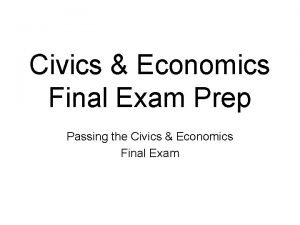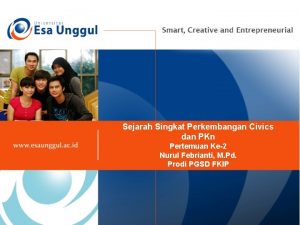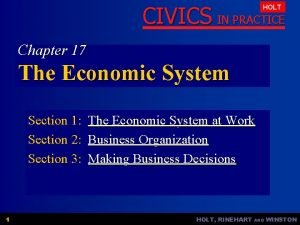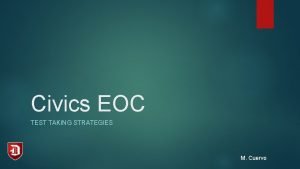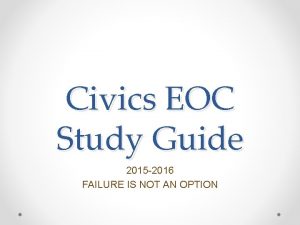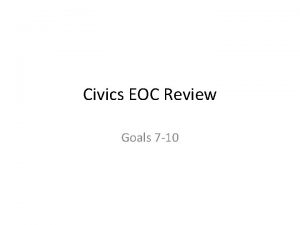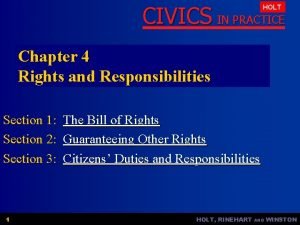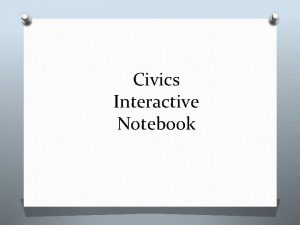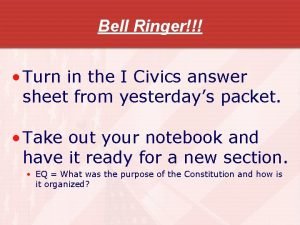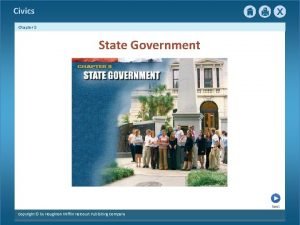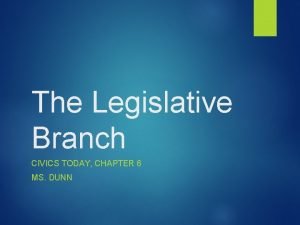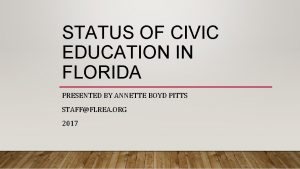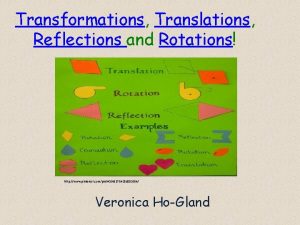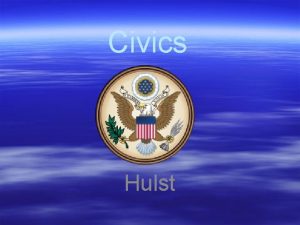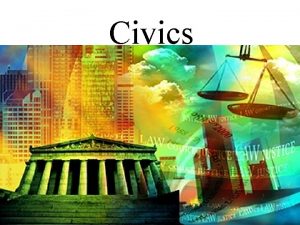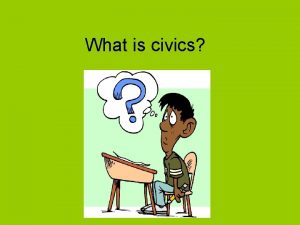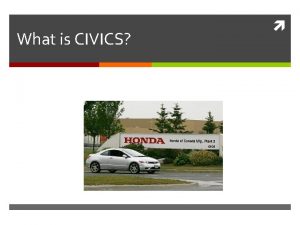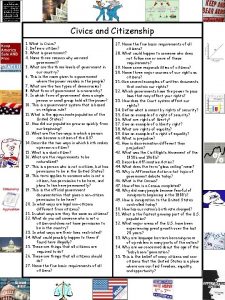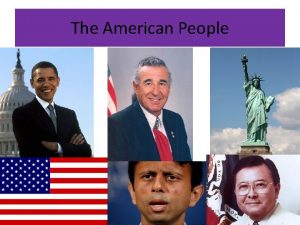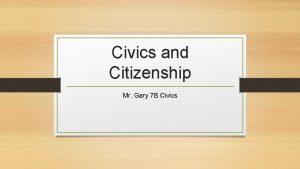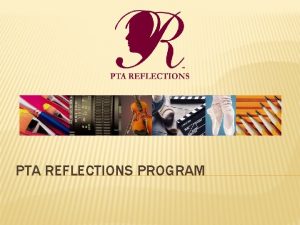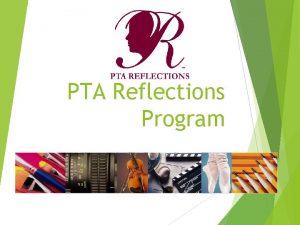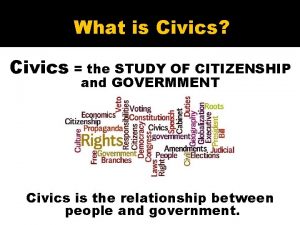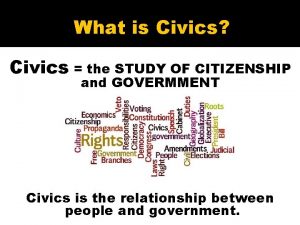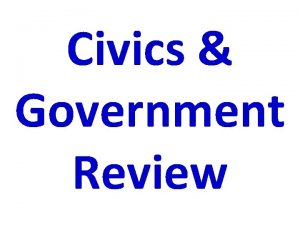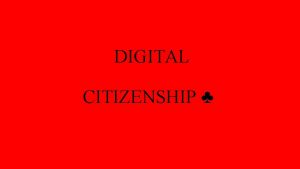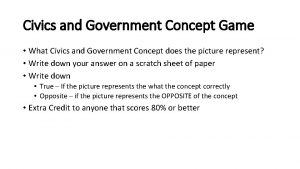The National Assessment Program Civics and Citizenship Reflections


















- Slides: 18

The National Assessment Program. Civics and Citizenship: Reflections on practices in primary & secondary schools Suzanne Mellor Senior Research Fellow, ACER Research Conference ‘Touching the Future: Building skills for life and work’ Brisbane - August 2008

Core Understandings about Engagement and Participation • What kinds of participation are available to citizens in a democracy? What kinds of participation do students think define a ‘good citizen’? • (Conventional) political participation (IEA 1999 study - Aust’n 14 Yr olds) Votes in every election Joins a political party Knows about the country’s history Follows political issues in newspaper, radio or TV Shows respect for government representatives Engages in political discussions (‘Important’ = 89%) (‘Important’ =17%) (‘Important’ = 55%) (‘Important’ = 50%) (‘Important’ = 67%) (‘Important’ = 34%) • Civic/social participation (Social Movement Citizenship) (IEA 1999) Would participate in a peaceful protest against a law believed to be unjust Participates in activities to benefit people in the community Takes part in activities promoting human rights Takes part in activities to protect the environment (57%) (80%) (68%) (74%)

Core Understandings about Engagement and Participation • What motivates citizens to participate, to actively engage? • What might motivate young citizens to participate? -the • Are their motives significantly different from those of other citizens? -desire to influence decision-makers, with personal or social dimensions desire to be heard rather than ignored, emotional reaction to a situation -NO, but unsurprisingly their concerns may be more focussed than for some adults -tend to have a global or intensely local view and may be very passionate -less interested in process … outcomes are what matter • What roles do attitudes and values play in these participations? -inclined to have a generally negative attitude to civic engagement - ‘What’s the point? ’ -prompted to act by their attitudes to/values about a situation they confront/observe -actions less confused when attitudes/values are underpinned by civic knowledge • What kinds of participation are young people attracted to exercise? -depends on perceived congruence between situation and the dimension -depends on levels of support offered by significant adults & peers -disposition to participate is related to skill levels in participation • What explanations are there for these patterns? -depends on skill levels in participation (and that relates to experiences) -depends on capacity to examine/analyse their own motivations & preferred outcomes

The National Sample Assessment in Civics and Citizenship undertaken at Years 6 & 10 in October 2004 (& 2007) • A national proportionally representative random sample of approx 600 primary and secondary schools across all states and territories • All Yr 6 and Year 10 students in two (one) selected classrooms per school (where existing) were tested – student sample of 20, 000 (12, 500) • The testing process required two hours of classroom time, with each student answering 40 -50 items, plus the Background Survey • The 120 -140 items were rotated across four (seven) different test booklets for each year-level, with item repetitions across the booklets. Each year-level booklet was administered in each class (thus each class attempted all items) • The test items require three kinds of response – Dual choice ( ) – Multiple choice ( ) – Short-extended (written responses 1 -4 lines in length) • Some items were discrete to Years 6 and 10, others ran at both yr levels

Survey of Students’ Citizenship Participation Opportunities • The Student Background Survey sought some basic student background details PLUS information about • Activities undertaken Outside School that involve or provide Civics & Citizenship learning • Opportunities for Civics & Citizenship participation In School • Student opinion on Civics and Citizenship understandings Learned at School • The data collected through this instrument was used to conduct multifactorial regression analyses, providing some explanations of factors in student achievement

Assessment Domain – Key Performance Measures 1 and 2 KPM 1: Civics: Knowledge & Understanding of Civic Institutions & Processes • Knowledge of key concepts and understandings relating to civic institutions and processes in Australian democracy, government, law, national identity, diversity, cohesion and social justice. • Civics is the study of Australian democracy, its history, traditions, structures and processes; our democratic culture, the ways Australian society is managed, by whom and to what end (What it is and how its elements work) KPM 2: Citizenship: Dispositions & Skills for Participation • • Understandings related to the attitudes, values, dispositions, beliefs and actions that underpin active democratic citizenship Citizenship education is the development of the skills, attitudes, beliefs and values that will predispose students to participate, to become and remain engaged and involved in that society/ culture/democracy (How and why one might engage…. )

Links between KPM 1 (Civics) and KPM 2 (Citizenship) • Both KPMs indicate there is a range of contested dimensions to be encountered in the teaching and learning of civics and citizenship - Interpretation lies at the heart of all Civics and Citizenship Education • The links point to the importance in the teaching of CCE of discussion as a pedagogy and to encouraging a flexibility to a range of opinions (Other research strongly indicates the importance of open classroom climates within critiquing school cultures to CCE learning) • Effective CCE learning and achievement involves the acquisition of a rich and complex set of understandings, based on both civics knowledge and attitudes/dispositions to participate • The interconnectedness of Civics and Citizenship were confirmed in the Assessment by the finding that student achievement on both KPMs could be captured by a single scale

Distribution of Yrs 6 & 10 students on C & C Scale (2004)

Reporting Student Achievement Results • The Report describes student achievement as measured against Proficiency Levels 1 -5 and the 2 year-level National Standards • The proficiency levels are identified on the scale and described • The national standards for both year levels were agreed by jurisdictional experts • The Year 6 Proficiency Standard was set at Level 2 Characteristics of Level 2 are described as: Students who achieved at Proficiency Level 2 were able to demonstrate accurate responses to relatively simple civics and citizenship concepts or issues, with limited interpretation or reasoning. They could, for example, identify more than one basic feature of democracy or democratic process, have basic understandings of citizens’ taxation and/or civic responsibilities, and recognise tensions between democratic rights and private actions. • The Year 10 Proficiency Standard was set at Level 3 Characteristics of Level 3 are described as: Students who achieved at Proficiency Level 3 were able to demonstrate comparatively precise and detailed factual responses to complex civics and citizenship concepts or issues, and some interpretation of information. They could, for example, identify the historical event remembered on Anzac Day, clearly understand the mechanisms and importance of secret ballot, and understand the general effect of sanctions in international agreements.

Main Findings Regarding Student Achievement Nationally the main finding is that student achievement is lower than expected, and also lower than can be regarded as satisfactory • Only 50% of the Yr 6, and 40% of the Yr 10, students achieved their Proficiency Standard • 20% of Yr 10 students did not achieve the Yr 6 Proficiency Standard Students had the greatest difficulty with • Understandings which relate to the concept of the common good (Especially with strategies individuals can adopt in order to influence civic institutions for the benefit of society, their role in a democracy and how they might work) • Key information about so-called ‘iconic’ knowledge of national events and nationally–representative symbols (Eg: Aust flag, Anzac Day) Some students demonstrated superior achievement (see Levels 4 & 5) Student achievement indicates that many are not receiving formal, consistently sequentially-constructed curriculum in CCE

Disaggregation of variance in student performance on the C&C Achievement Scale

Year 6 Achievement and Participation in School Governance Activities Higher Achievement in C&C Lower

Year 10 Achievement and Participation in School Governance Activities Higher Achievement in C&C Lower

Achievement and Cumulative Participation in School Governance Activities Higher Achievement in C&C Lower

Australia’s current school-aged citizens’ readiness for civic life • Current Australian student achievement in C&C indicates students are not being adequately prepared to meet the National Goal for Schooling(1. 4) ‘To be active and informed citizens with an understanding and appreciation of Australia’s system of government and civic life’ The findings show: • Civics knowledge and citizenship dispositions to participation and engagement can be learned and taught (and assessed!) • Civic knowledge & understandings and participation in citizenship activities are strongly-interconnected, supporting the premise that BOTH civic knowledge and a disposition to engage are needed for effective citizenship • Because they are linked they are best taught together, or in tandem • These findings are supported by previous research in the field • These findings require students have more opportunities to be taught civic knowledge and to experience participation in school governance and activities in the broader community – that is to hone their civic competencies

This IS school’s business – what changes need to be made? • Developing a school culture which has CCE as core business: (discussion by staff and administrators to identify new school’s priorities in CCE, and include those learning outcomes in School Charters and Mission statements) • Development of explicit links between CCE curriculum and other school programs, always distinguishing between Civics and Citizenship outcomes • Writing programs with explicit CCE learning outcomes and developing pedagogies suitable for delivering CCE inside & outside classrooms • Provision of PD programs by schools to ‘skill up’ and engage a broader range of staff in CCE, to both model and practise active CCE at school • Changing the school’s governance structures and processes, so that many students get opportunities to participate in real decision-making at school • Ensure most students in that school can actively engage with their broader community in a range of ways • School-aged citizens, so taught, will have greater civic competence and be more disposed to active engagement than the current cohort.

Some relevant weblinks • The National Assessment Report: Civics and Citizenship (2004): http: //www. mceetya. edu. au/verve/_resources/Civics_and_Citizenship_Years_ 6_10_Report. pdf • School Assessment Materials (2004): http: //www. mceetya. edu. au/mceetya/default. asp? id=18052 • National Statement of Learning-Civics and Citizenship: http: //www. mceetya. edu. au/verve/_resources/SOL_Civics. Citizenship. pdf • ‘Solving some Civics and Citizenship Education Conundrums’ (article by Suzanne Mellor) is available online at: http: //www. civicsandcitizenship. edu. au/cce/default. asp? id=9318 • An assessment PD Unit developed by ACER is online at: http: //www. civicsandcitizenship. edu. au/cce/professional_learning, 9013. html mellor@acer. edu. au

(especially school-based research by Mellor, Hahn, Holdsworth, Kennedy et al)
 Civics and economics final exam
Civics and economics final exam Civics and economics definition
Civics and economics definition Sejarah perkembangan civics
Sejarah perkembangan civics Mr raymond civics
Mr raymond civics Civics sol review
Civics sol review Civics in practice
Civics in practice Civics eoc exam
Civics eoc exam Civics eoc study guide
Civics eoc study guide Civics eoc review
Civics eoc review Civics eoc practice test
Civics eoc practice test Civics in practice
Civics in practice Civics interactive notebook
Civics interactive notebook Lejsasr
Lejsasr Civics
Civics Chapter 8 civics
Chapter 8 civics What is civics
What is civics Civics today chapter 6
Civics today chapter 6 Flrea civics
Flrea civics Translations reflections and rotations
Translations reflections and rotations
